Star Wars: The Old Republic immerses players in a galaxy defined by the conflict between the Galactic Republic and the Sith Empire. The game features intricate story arcs shaped by player choices, influencing character development and narrative outcomes. Players explore various factions, each with unique philosophies, while engaging in diverse storylines that reflect their moral alignments. This dynamic interplay creates a rich, personalised gameplay experience that enhances emotional investment and community interaction.
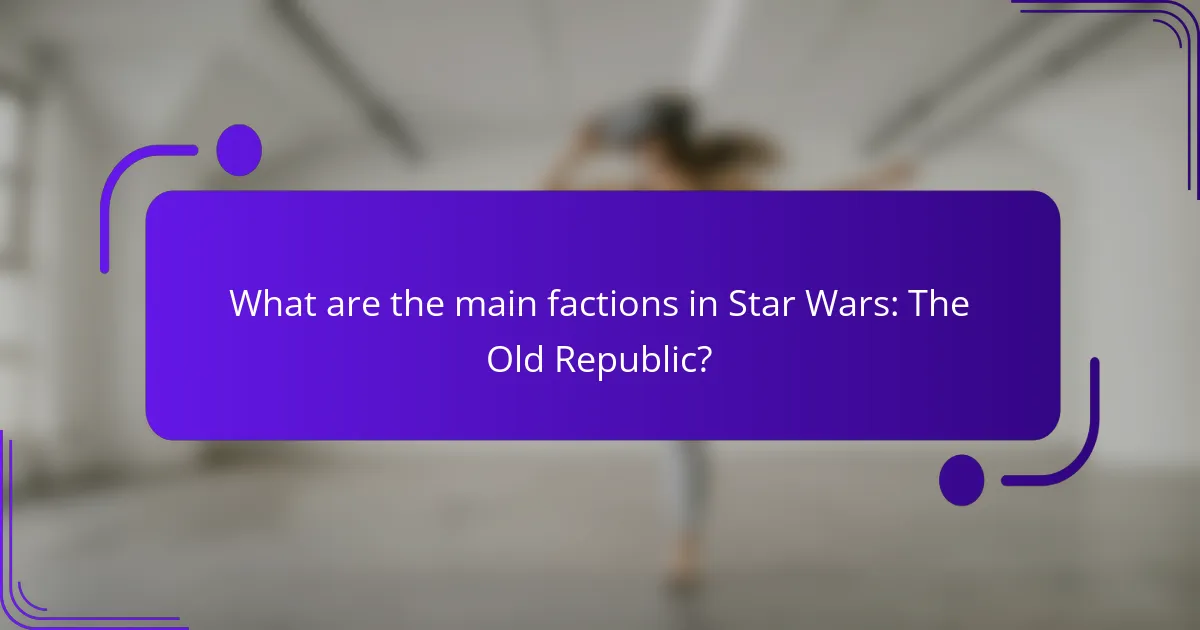
What are the main factions in Star Wars: The Old Republic?
The main factions in Star Wars: The Old Republic are the Galactic Republic and the Sith Empire. The game features intricate story arcs influenced by player choices, shaping the narrative experience.
The Galactic Republic values democracy, freedom, and justice, aiming to protect the galaxy from tyranny. It includes Jedi Knights, who serve as peacekeepers.
The Sith Empire, in contrast, embraces power and domination, led by Sith Lords. Their philosophy promotes strength through conflict and ambition, often clashing with the Republic’s ideals.
Players can align with either faction, impacting their story progression and character development. Choices made throughout the game further enrich the narrative, offering unique experiences based on faction allegiance.
How do the Jedi Order and Sith Empire differ in gameplay?
The Jedi Order and Sith Empire differ significantly in gameplay style and philosophy. Jedi focus on light-side abilities, emphasizing healing and support, while Sith utilize dark-side powers for damage and control.
Jedi gameplay often involves defensive tactics, with skills that enhance survivability and group support. In contrast, Sith gameplay prioritises aggressive offensive strategies, enabling players to deal high damage and manipulate opponents.
The moral choices available to players also diverge. Jedi align with choices that promote harmony, while Sith decisions often lead to chaos and power struggles. This fundamental difference shapes the narrative and player experience in “Star Wars: The Old Republic.”
What roles do the Galactic Republic and Sith Empire play in the story?
The Galactic Republic and Sith Empire are central to the conflict in Star Wars: The Old Republic. The Galactic Republic represents democracy, peace, and the Jedi Order, while the Sith Empire embodies tyranny, ambition, and the dark side of the Force. Their opposing ideologies drive the narrative and influence player choices throughout the game. Players navigate alliances, rivalries, and moral dilemmas shaped by these factions, impacting story arcs and character development. The struggle between light and dark shapes the universe, making the factions crucial to the player’s journey.
How do the factions influence player choices and alliances?
Factions significantly shape player choices and alliances in Star Wars: The Old Republic. Each faction offers unique story arcs, moral dilemmas, and gameplay mechanics, influencing player decisions and interactions.
Players align with factions based on personal values and desired outcomes. For example, choosing the Sith Empire aligns with darker, power-driven narratives, while the Galactic Republic promotes heroism and justice. These choices impact relationships with NPCs and other players, altering the game’s progression and outcomes.
The dynamic between factions creates a competitive environment, where players must navigate alliances and rivalries. This interaction fosters a rich storytelling experience, enhancing immersion and engagement. Ultimately, faction allegiance drives the narrative’s direction, making it a crucial element in player experience.
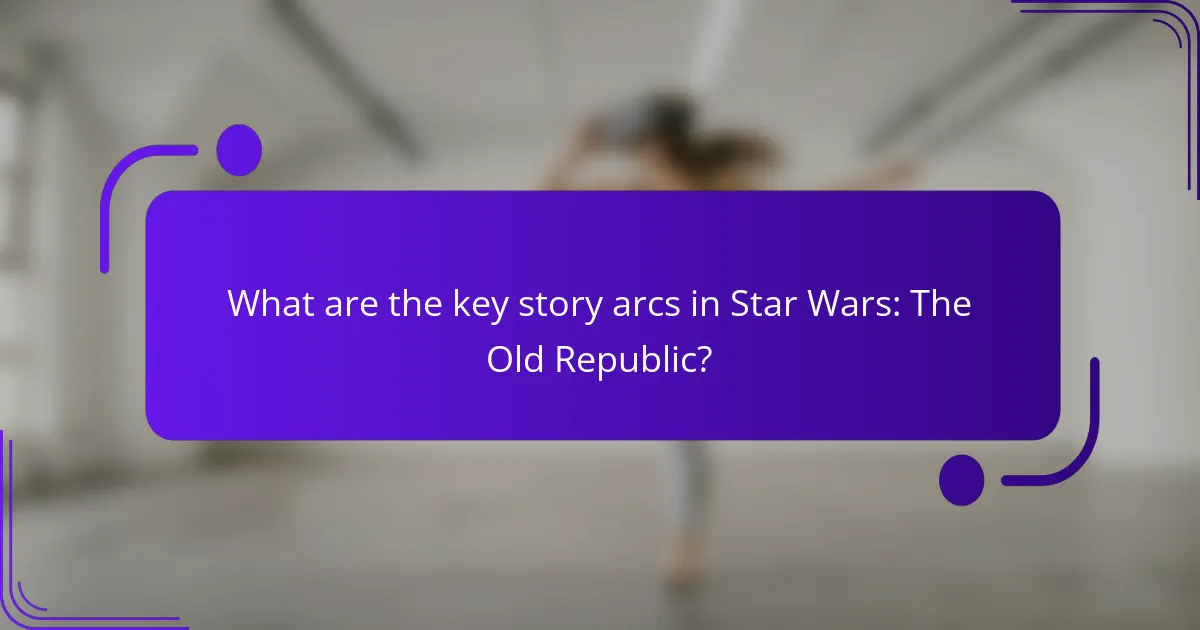
What are the key story arcs in Star Wars: The Old Republic?
The key story arcs in Star Wars: The Old Republic include the conflict between the Sith Empire and the Galactic Republic, the rise of the Jedi Order, and individual character journeys influenced by player choices. These arcs encompass themes of redemption, power struggles, and the consequences of decisions made throughout the game. Players experience unique narratives based on their chosen faction, class, and moral alignments, leading to diverse outcomes and rich storytelling. Each arc contributes to the overall lore, enhancing the immersive experience of the Star Wars universe.
Which major events shape the narrative throughout the game?
Major events that shape the narrative in Star Wars: The Old Republic include pivotal story arcs and faction conflicts. The Sith Empire’s resurgence drives the main conflict, while the Galactic Republic’s struggle to maintain order adds depth. Player choices significantly influence outcomes, creating personalised experiences. Key moments, such as the betrayal of characters and the discovery of ancient artifacts, further enrich the storyline. Each event intertwines, impacting character development and faction dynamics, ultimately shaping the player’s journey through the galaxy.
How do story arcs vary between different character classes?
Story arcs in “Star Wars: The Old Republic” vary significantly across character classes, reflecting their unique motivations and goals. Each faction offers distinct narratives that shape player choices, influencing the overall experience. For instance, Jedi characters often focus on themes of peace and justice, while Sith may explore power and ambition. The complexity of choices available to players leads to diverse outcomes, enhancing replayability and engagement. Additionally, unique attributes, such as class-specific companions and storylines, further differentiate the arcs, creating a rich tapestry of narratives within the game.
What impact do player choices have on story outcomes?
Player choices significantly influence story outcomes in “Star Wars: The Old Republic.” Decisions shape character arcs, faction relationships, and narrative progression. Players can align with different factions, impacting storylines and available quests. Unique attributes, like the alignment system, further differentiate player experiences. Choices can lead to distinct endings, enhancing replayability and engagement.
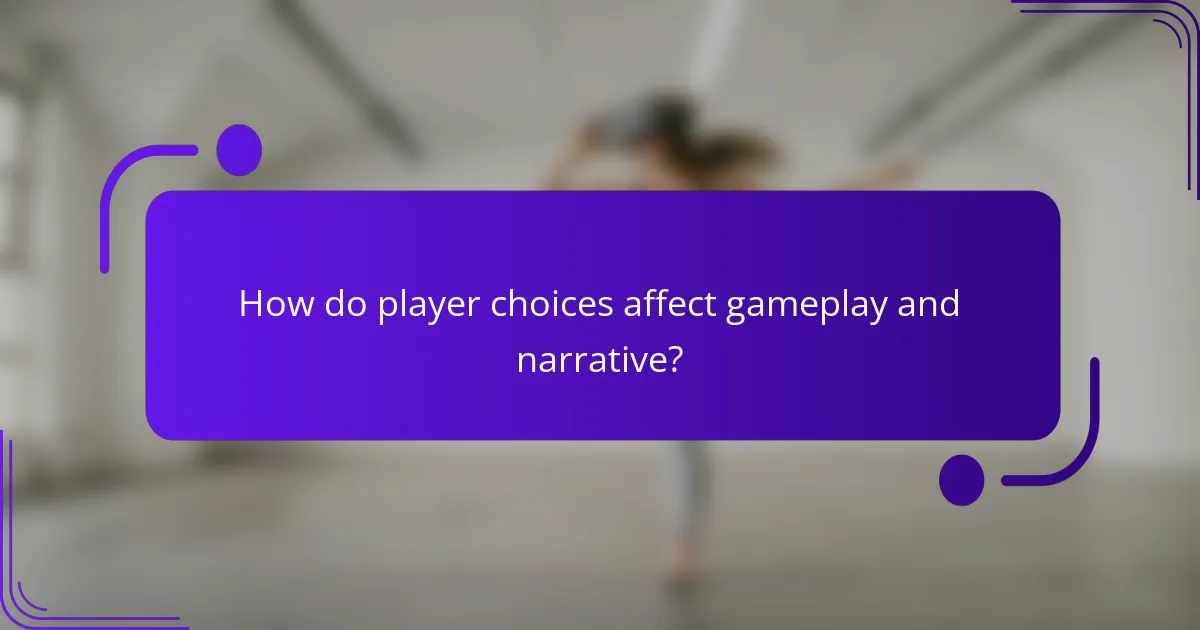
How do player choices affect gameplay and narrative?
Player choices significantly shape gameplay and narrative in “Star Wars: The Old Republic.” These choices influence faction alignment, story arcs, and character development. Players can select different paths that lead to unique outcomes, affecting relationships with NPCs and the overall storyline.
The game features various factions, each with distinct philosophies and goals. Choosing a faction determines available missions and alliances. Story arcs branch based on player decisions, leading to different endings and experiences. For example, a light-side character may resolve conflicts peacefully, while a dark-side character may choose aggression.
Additionally, player choices impact character customisation and abilities. Unique attributes, such as class abilities and moral alignment, further differentiate gameplay experiences. The interplay of these elements creates a rich, immersive narrative that responds dynamically to player actions.
What are the consequences of light side versus dark side decisions?
Light side decisions promote harmony and cooperation, while dark side decisions lead to conflict and betrayal. In “Star Wars: The Old Republic,” these choices significantly impact story arcs and faction relationships. Light side players often gain allies and positive reputation, enhancing gameplay through support and resources. Conversely, dark side players may experience immediate power and fear but face long-term consequences such as isolation and loss of trust. These dynamics create a rich narrative experience, emphasizing the moral weight of player choices.
How do moral dilemmas enhance player engagement?
Moral dilemmas enhance player engagement by creating deeper emotional connections and fostering critical thinking. In “Star Wars: The Old Republic,” players face choices that impact story arcs and faction dynamics. This interactivity encourages investment in character development and narrative outcomes. Players experience a sense of agency, making decisions that resonate with their values and ethics. As a result, the game’s immersive storytelling is enriched, leading to increased replayability and community discussions around moral implications.
Which choices lead to unique story paths and endings?
Choices in “Star Wars: The Old Republic” lead to unique story paths and endings through faction alignment, character decisions, and quest outcomes. Players can join different factions, such as the Sith Empire or Galactic Republic, affecting narrative direction. Key choices during dialogues and missions shape character relationships and influence the fate of the galaxy. Unique attributes like class-specific story arcs provide additional layers of personalization, resulting in diverse experiences for each player. The interplay of these elements ensures that no two playthroughs are identical.

What are the unique character classes available in the game?
Star Wars: The Old Republic offers unique character classes that shape gameplay experiences. The available classes include Jedi Knight, Jedi Consular, Sith Warrior, Sith Inquisitor, Trooper, Smuggler, Imperial Agent, and Bounty Hunter. Each class possesses distinct abilities and story arcs, enhancing player choices within the game. Jedi Knights focus on melee combat and protection, while Jedi Consulars emphasize support and healing. Sith Warriors excel in damage dealing, and Sith Inquisitors utilize dark side powers. Troopers are versatile soldiers, Smugglers rely on cunning tactics, Imperial Agents specialize in stealth, and Bounty Hunters are skilled in tracking and combat.
How does each class contribute to the overall gameplay experience?
Each class in Star Wars: The Old Republic significantly shapes gameplay through unique abilities and narrative paths. Classes like Jedi Knights offer powerful lightsaber combat, while Sith Inquisitors focus on dark side sorcery.
The roles of classes create diverse team dynamics. For instance, Tanks absorb damage, Healers restore health, and DPS classes maximize damage output. This variety enriches player interactions and strategic planning during missions.
Story arcs are influenced by class choices, impacting character development and moral decisions. Players experience different perspectives on the overarching conflict between the Galactic Republic and the Sith Empire, enhancing replayability.
Ultimately, the distinct contributions of each class foster a personalised gameplay experience, making every player’s journey unique within the expansive Star Wars universe.
What unique abilities do different classes possess?
Different classes in Star Wars: The Old Republic possess unique abilities that enhance gameplay. Each class has specialized skills tailored to specific roles, such as damage dealing, healing, or tanking.
For example, Jedi Knights excel in melee combat with abilities like Force Leap and Saber Throw, while Sith Sorcerers utilize dark side powers to deal damage and heal allies. Troopers focus on ranged attacks, using abilities like Barrage and Explosive Round. Each class’s unique abilities shape their playstyle and influence player choices within the game’s factions and story arcs.
These distinctions create a diverse gameplay experience, allowing players to choose a class that aligns with their preferred strategy and narrative journey.
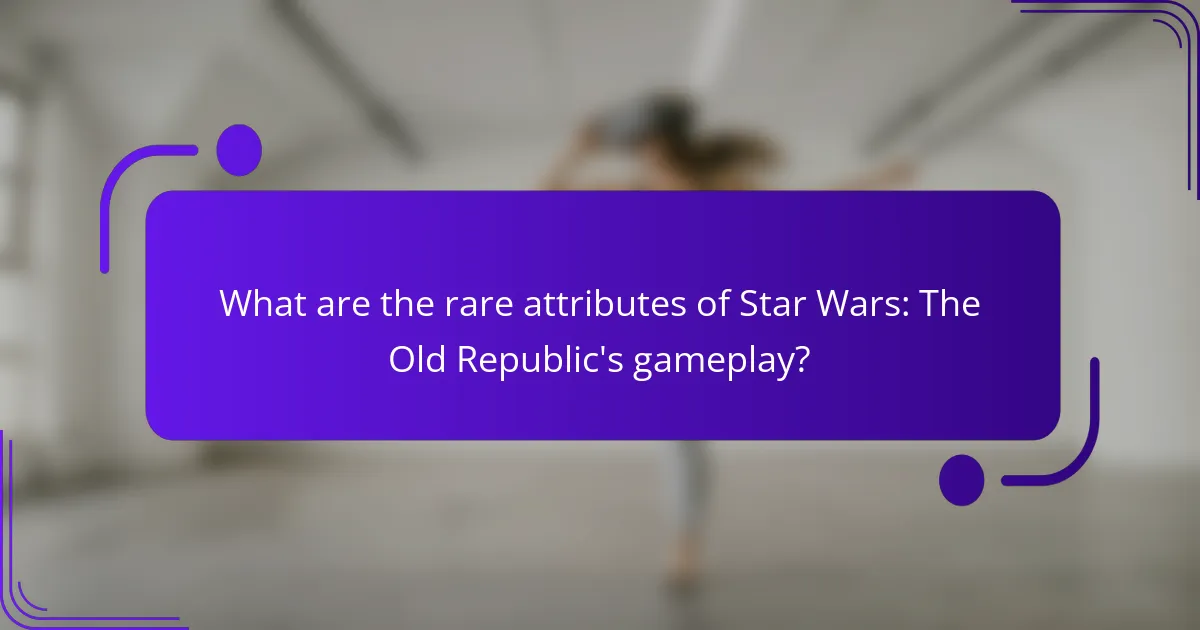
What are the rare attributes of Star Wars: The Old Republic’s gameplay?
Star Wars: The Old Republic features rare attributes like unique companion interactions, dynamic story outcomes, and faction-specific gameplay elements. These aspects enhance player immersion and provide distinct experiences. The game allows for personalized story arcs based on player choices, resulting in varied gameplay that is not commonly found in other MMORPGs. Additionally, the legacy system offers unique character progression pathways that further differentiate the gameplay experience.
How do limited-time events and expansions shape the game experience?
Limited-time events and expansions significantly enhance the game experience in Star Wars: The Old Republic by introducing dynamic content and player engagement. These events create urgency, motivating players to participate in unique challenges and rewards that are not available year-round.
Expansions often introduce new story arcs and factions, deepening the narrative and providing fresh gameplay mechanics. For instance, the addition of new classes or abilities allows players to explore different aspects of the game’s universe. This encourages diverse player choices and interactions, as players may align with new factions or explore new storylines that impact their overall journey.
The limited-time nature of events fosters a sense of community, as players often collaborate to achieve common goals. This collective effort can lead to memorable experiences and strengthen social bonds within the game. As a result, players are more likely to remain engaged and invested in the game’s evolving landscape.
What are some exclusive items or rewards tied to specific factions?
Exclusive items and rewards in “Star Wars: The Old Republic” vary by faction. Each faction offers unique gear, mounts, and achievements that enhance gameplay.
For example, the Sith Empire provides exclusive lightsabers and armor sets, while the Galactic Republic offers unique starships and customization options. Additionally, certain achievements tied to faction story arcs grant players special titles and rewards.
These exclusive items not only reflect the player’s allegiance but also enhance their character’s abilities and status within the game.
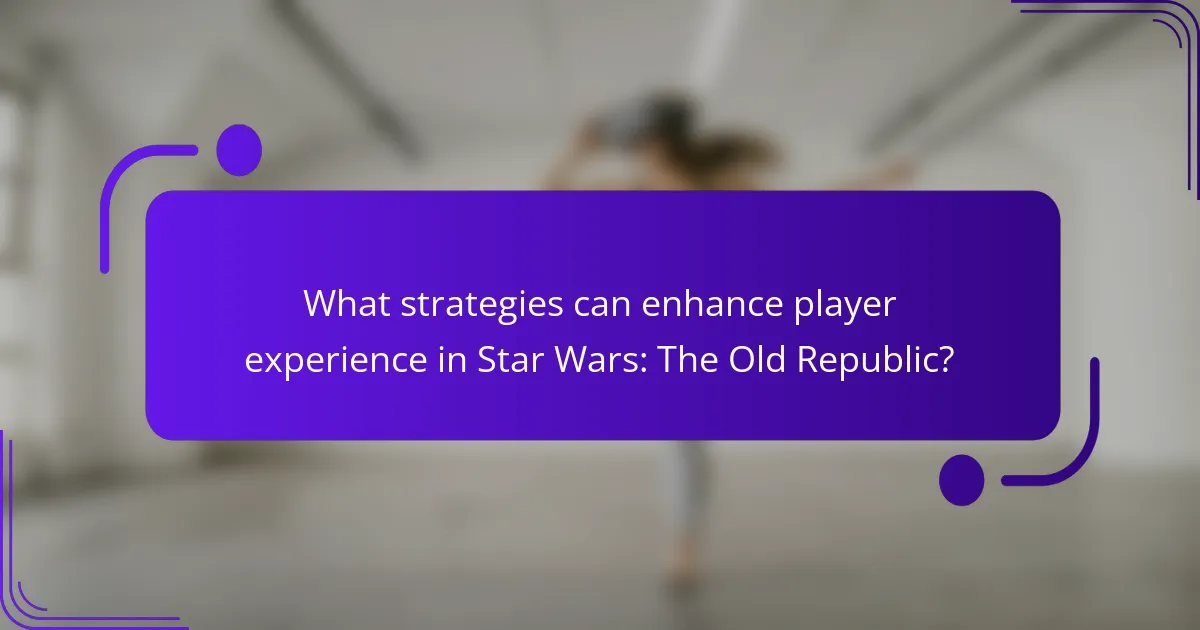
What strategies can enhance player experience in Star Wars: The Old Republic?
To enhance player experience in Star Wars: The Old Republic, focus on immersive storytelling, meaningful player choices, and engaging faction dynamics. These elements deepen emotional investment and foster community interaction.
Players can explore diverse story arcs that reflect their choices, impacting the game world and character relationships. Engaging with faction-specific content can enrich gameplay, as players align with groups that resonate with their values.
Additionally, incorporating regular updates and community events creates a vibrant environment, encouraging players to connect and collaborate. Customization options for characters and gear further enhance personal investment in the game.
Overall, prioritising narrative depth, player agency, and community engagement significantly elevates the experience in Star Wars: The Old Republic.
What are the best practices for selecting factions and story arcs?
To select factions and story arcs effectively in Star Wars: The Old Republic, prioritise alignment with your character’s class and personal playstyle. Consider the narrative depth and impact of choices on gameplay. Explore the benefits of faction-specific quests and story arcs that enhance immersion and engagement. Evaluate how player choices shape the overall experience and lead to unique outcomes, fostering a sense of agency in the game.
How can players optimize their choices for maximum enjoyment?
Players can optimize their choices for maximum enjoyment by aligning their decisions with personal playstyle and narrative preferences. Engaging deeply with faction story arcs enhances immersion and emotional connection. Prioritising character development and interactions leads to richer experiences. Exploring diverse choices across different playthroughs reveals unique outcomes and perspectives, increasing replay value.
What common mistakes should players avoid when navigating the game?
Players should avoid common mistakes like neglecting faction choices, overlooking story arcs, and mismanaging resources. Failing to understand faction dynamics can lead to missed opportunities for alliances and rewards. Ignoring story arcs may result in a disjointed experience and lost character development. Additionally, poor resource management can hinder progress and limit gameplay enjoyment. Prioritising these aspects enhances overall engagement and success in “Star Wars: The Old Republic.”